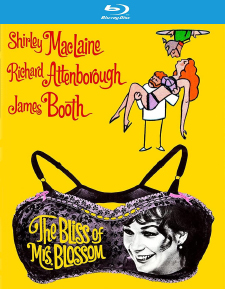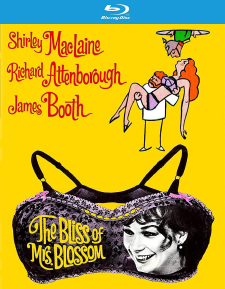Bliss of Miss Blossom, The (Blu-ray Review)

Director
Joseph McGrathRelease Date(s)
1968 (February 28, 2023)Studio(s)
Paramount Pictures (Kino Lorber Studio Classics)- Film/Program Grade: D
- Video Grade: A-
- Audio Grade: A-
- Extras Grade: B-
Review
I say it’s high time all of us admit that the type of screwball, anything-goes, swingin’ ‘60s London comedies we all once thought so hilariously irreverent and sophisticated were, in fact, quite awful.
I’m talking about that very specific type of film that seems to have begun with What’s New, Pussycat? (1964) and continued with pictures like Casino Royale (1967) and The Magic Christian (1969), finally petering out in the early ‘70s. While a few good films incorporating some elements from this once-in-vogue style emerged relatively unscathed—The Italian Job (1969) comes to mind—on the whole, looking at them now, films my generation snickered with delight at college campus screenings in the ‘70s and ‘80s, viewed today, are insufferable and sophomoric.
Such films are like highly inefficient air conditioners, noisy machines that use an extraordinary amount of electricity yet barely cool a room more than a degree or two. Similarly, one can’t help but cringe at the time, money, and resources expended on so few laughs.
A lesser-known example is the perfectly dreadful The Bliss of Mrs. Blossom. The film has the air of a pleasant, intimate little three-character play bludgeoned to death by its own frenetic pseudo-hipness.
The basic idea is not without promise: Robert Blossom (Richard Attenborough, who coincidentally played another character named Blossom in Doctor Dolittle (1967), but has no connection with that character nor, for that matter, actor Roberts Blossom) is the president of a company manufacturing brassieres. One day he innocently sends machinist Ambrose Tuttle (James Booth) to fix his wife Harriet’s (Shirley MacLaine) old sewing machine. Harriet, lonely because her husband spends so much time at his company, seduces Ambrose, whom she hides in the attic upon her husband’s return.
The next morning, however, Ambrose decides he rather likes it up there, eventually hiding in the attic indefinitely so that the affair can continue. As Ambrose never returns to work or his (never-seen) home, gay police Det. Sgt. Dylan (Freddie Jones) launches an investigation into Ambrose’s disappearance, while Harriet enjoys the benefit of both a husband and a lover, each with his good points.
What might have been a funny and perceptive character piece—one can imagine what Albert Brooks might have done, working from the same premise—is completely thwarted by filmmakers trying way, WAY too hard to be hip and hilarious. For one thing, there are pointless fantasy sequences. In one Ambrose fences with musketeers, in another he’s a Mexican bandito in the old west, and in still another he’s a knight saving princess Harriet from a dragon. All of these sequences are extravagantly done, the latter even featuring a full-scale, articulated dragon prop that seems original to this production. These scenes look expensive yet generate zero laughs.
In the film’s biggest-scale sequence, Blossom unveils an innovative brassiere at a huge unveiling resembling a big political convention involving hundreds of extras and a King Kong-size statue of a woman wearing the new brassiere; she’s at least 40 feet in height. Fashion models representing countries from all over the world eventually float upward toward the ceiling (don’t ask), a gag that must have entailed tricky high-wire stunt work. I’ve been unable to find any information about the picture’s budget, but it had to have cost upwards of $4-6 million, huge for this kind of film at that time. But for what?
Films like The Bliss of Mrs. Blossom aggressively use props and production and cinematic stylization to generate laughs by themselves, all at the expense of character and plot or even believability. It would have been interesting, rife with comic potential, to explore how Ambrose lives in the attic undetected by Blossom—Laurel & Hardy’s attic antics in Sons of the Desert being a prime example of such a premise expertly, hilarious done. Instead, Ambrose outfits his hideaway with all kinds of outrageous things never remotely credible on any level—he installs a full bath and full kitchen, at one point banks of ‘60s-imagined high-tech computers (left over from another film?), and even a working periscope. Less would’ve been more.
By the end of the film the audience knows little more about the three characters than they did at the beginning, nor do they feel much of anything for them or their problems. Yet, in such pictures, the performances are usually good, and this is no exception: MacLaine, Attenborough, and Booth are all fine, and many fine British players including Jones, Bob Monkhouse, Patricia Routledge, Sheila Steafel, Frank Thornton, Barry Humphries, John Cleese (in his first film role) appear in short scenes, do their best, and disappear. Likewise, cinematographer Geoffrey Unsworth and composer Riz Ortolani (aided by Jack Jones vocals) contribute work better than the film deserves.
Reportedly finished in 1966 but not released until September 1968, one imagines Paramount executives bemused by the film and clueless how to market it. Contemporary critics were surprisingly easy on the film, though it’s unclear whether if it was profitable or not. Glaswegian director Joseph McGrath worked with both Richard Lester and The Beatles during the A Hard Day’s Night / Help! era, and was also closely aligned with various Goon Show stars, McGrath directing Peter Sellers for his scenes in Casino Royale and in The Magic Christian, and Spike Mulligan’s interesting The Great McGonagall (1974) and the disastrous Digby, the Biggest Dog in the World (1974).
Kino’s Blu-ray, licensed from Paramount, presents the film via a new 4K transfer from the original camera negative. Though there are a lot of process shots, straight cuts look impressively sharp; MacLaine’s freckles are unusually visible here, and the color pops throughout. The English DTS-HD Master Audio (2.0) mono is also above average, with optional English subtitles provided on this Region “A” encoded disc.
The only extra is a new audio commentary track by filmmaker and film historian Daniel Kremer. It’s an okay track, though Kremer doesn’t talk about the film specifically all that much, diverting much of his track to other films made by those involved in its production and of Paramount generally during this period.
That’s perhaps understandable, given that The Bliss of Mrs. Blossom, in the final analysis, is such an empty film, busy but frivolous, a product of its time, but from which a much better film could have been made.
- Stuart Galbraith IV

